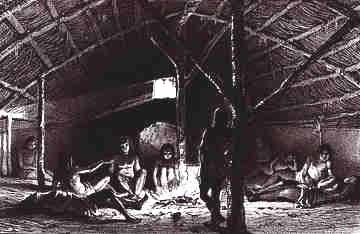Direct Fire 
The hot air bath of upper California depecited by Alexander Forbes in the early 1880s.
Alaskan Eskimos, some Pacific Coast tribes and the Pueblo Indians in the Southwest built lodges heated directly by fire. They were usually large enough to accomodate dozens of men. A small pilot fire was kept burning most of the day. After hours of talk, gossip and dancing the fire was fed to a noble size, the lodge became torrid and sweating began.
Although caustic smoke filled the air, these people made no effort to convert to the hot rock method, though they surely knew of this alternative. Without stoves or chimneys, a blazing central fire was the simplest way to convert a men's club into a sudatorium. When the smoke became unbearable, the men would simply lie flat on the floor and breathe fresher air.
The Eskimos used the kashim as their social and religious center. It was a rectangular wooden structure, large enough to house bachelors and male travelers and as a clubhouse for married men. They were dug partially underground, insulated with dirt or sod with a single tunnel entrance and a small hole in the roof for smoke to escape. This style plank house was found along the Pacific Coast as far south as northern California. Central Alaskan Eskimos, lacking timber, never built sweat lodges. Aleutian Eskimos never built the sweat lodge until it was introduced by Russian traders in the early 18th century.
The Sweat Lodge and Spirit Since ancient times, people have understood that their spirits are nourished through religious ceremonies. Sacrifice, prayer and self-denial have long been rituals through which people have found peace of mind.
American Indians may experience visions or revelations from their Creator through dreams or by performing certain rituals. Just as Christians pray for guidance during church services, many Indians find that using a sweat lodge heightens their spiritual and religious awareness.
A sweat lodge, also known as a sauna, is heated by fire or by pouring water over hot stones. Heat and steam cleanse the body, and they can also purify the spirit or soul.
In addition to visiting a sweat lodge, some Indians meditate and fast in order to receive a vision to guide them. They may seek answers to a particular question, or look for broad answers which will help them live with dignity and honor on their journey through life.
Youth use the fasting and meditation ritual in order to understand how to be of service to their People when they enter the adult world. It helps prepare them for a time when they might have to go without food by helping them understand their own bodies and the value of sharing. Ojibwe children are encouraged to find their own understanding of life. They may go alone into the woods or wilderness and fast as a way to receive their own guardian spirit.
Meditation, fasting and cleansing can enhance the spiritual lives of all people, whether they are Indian or not.
 Free Forum Hosting
Free Forum Hosting